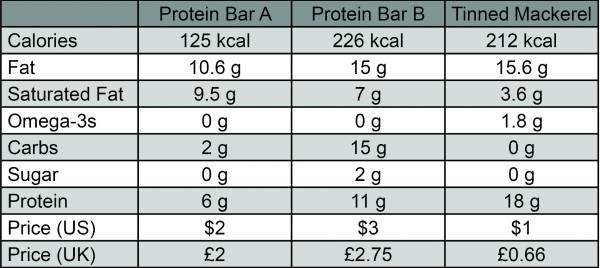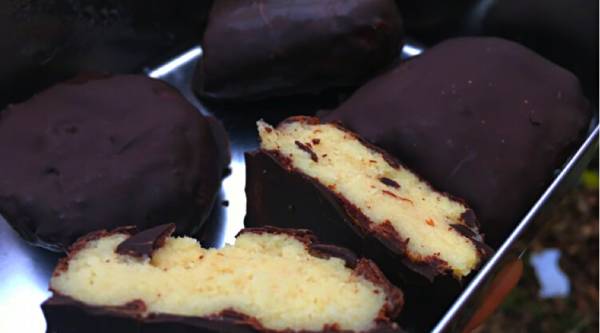Learning how to eat better is one of the keys to long-term health and happiness. It may even be the most important thing we need to do in order to kick ass for as long as possible. I am a huge fan of anybody trying to find their own way to a diet that nourishes them and their family.
And I have spent over a decade watching various “real food” movements gather momentum. Their overriding message is that we should stop relying on processed foods and re-learn how to prepare and cook our own meals from basic ingredients. Despite this message, each movement still seems to come with its own set of “wholesome” snack or protein bars that, in reality, are anything but wholesome.
Many people see dramatic health benefits by eliminating gluten or reducing carbohydrate intake, and many of these bars are ostensibly designed to support that. But if you’re an advocate of real food – the exact market that these bars are targeted at – your first response should be caution.
Approach products like this with caution.
These bars aren’t exactly the worst things to feed yourself or your kids, but at best they’re a stop-gap approach that provide some macronutrients with no real nourishment. I think there are cheaper, easier, and healthier alternatives regardless of your time or budget.
Where I Draw The Line
The protein bar sales pitch usually goes:
“For optimal health we need to eat whole, unprocessed, real food. Buying my wholesome bar made from various powders and oils will help you do that.”
Even if you R on a Quest to Adapt to a paleo or low carbohydrate diet in order to make yourself Bulletproof: does that reasoning make sense? Don’t get me wrong. I have nothing against finding convenient foods that support your health and goals. Supplementing your diet with processed protein sources can be a part of that, especially if you have a high training load or are maintaining a caloric deficit.
But some companies, with support from prominent names and healthcare professionals, are now making low carb protein bars aimed at children. This is where I draw the line. Once we’re pushing this stuff on kids, we’re completely undermining the food relationship we are trying to better. We want to teach our children that modern processed food is the reason we have a chronic health burden in the Western world. We are not trying to teach them that any food is fine as long as it is gluten free and low in carbs.
We got to where we are today because we have become completely disconnected from the food that we eat, and this is what we should be trying to overcome. The most sustainably-sourced organic protein bar isn’t going to fix that. As a good friend of mine said about these types of bars :”This is what selling out looks like. A slightly different version of the same shit that got you into trouble in the first place.”
Practical Alternatives to Processed Protein Bars
I can’t really complain about the makers of these bars. They are filling a huge gap in the market. But I wonder why these gaps in the real food market exist. Aside from the occasional post-gym emergency when there is no food in sight for the next few hours, there are few situations that justify reaching for a paleo or low-carb protein bar. For the ones that do, let’s look at the better alternatives.
Situation #1: I Need A Snack
One of the simplest ways to improve blood sugar control and metabolic health is to decrease meal frequency and reduce snacking. The better alternative here is just to think twice. Do you really need to eat, or is something else other than hunger (like boredom) making you reach for that snack?
Situation #2: No Seriously, I Need A Snack
Then let me introduce you to the ultimate protein-packed, low-carb treat: tinned fish. The smaller the fish the better. Don’t go for that skinless and boneless stuff, get the whole fish. Tinned sardines and mackerel are pressure cooked, which makes the skin and bones almost impossible to notice. No need to eat protein bars with added collagen powder. This is a brilliant way to get some portable nutrition. Don’t like fish? At least promise you’ll try it. Below is a table to show how tinned mackerel stacks up against popular snack bars in the low carb and paleo worlds.

How the mighty mackerel measures up.
Need some additional carbs after a workout? Get the mackerel in tomato sauce (my favourite), and have a banana. Want more fat? Add an avocado. Worried about the endocrine-disrupting chemicals from the lining of tin cans? Don’t think that your protein bar is going to be any better after it has sat melting inside of its plastic wrapper at the bottom of your bag all day. I’d take the fish any time. Beef jerky and nuts are another good option, but can get expensive very quickly, though you can easily make your own jerky. I’m also a big fan of boiled eggs.
Situation #3: I Want a Low-Sugar Way to Treat the Kids
Great! Why not make your own? Better yet, get the kids in the kitchen and show them how easy and fun it can be to cook. The internet is full of various recipes for treats, snacks, and protein bars that fit your health needs. Most require minimal preparation, and can be made in under 15 minutes. My fellow Breaking Muscle coaches Matt and Keris from Fitter Food have put together just such a recipe below.
Recipe: Chocolate Orange Protein Bars

Serves: 4
Prep: 15 minutes
Per serving: 228 calories, 5g carbs (3g sugar), 19g fat, 19g protein
Ingredients:
- 50g natural whey protein (unflavoured or you can use vanilla)
- 90g ground almonds
- 25g coconut flour
- 1 tbsp orange extract
- 80-100ml almond milk (unsweetened)
- 50g dark chocolate, 85% cocoa, melted
- Optional: stevia drops, xylitol or honey to taste.
- Feel free to add a little more orange essence to the melted chocolate too.
- You can use any other preferred protein powder if avoiding dairy.
Method:
- Place the whey, almonds and coconut flour in a large bowl and mix together.
- Add the orange extract and SLOWLY add the almond milk little by little. You want to avoid the mixture becoming to soggy so start by adding half the amount and mix with your hands, then add a little more until the mixture forms a doughy paste that you can shape into bars without it sticking to your hands. If it gets too soggy add some more ground almonds, if the mixture isn’t sticking together add a little more almond milk.
- Once combined shape into 4 bars before placing on some greaseproof paper or a plate and popping into the freezer to firm up a little.
- Break the chocolate up into a heatproof bowl and melt in the microwave or over a pan of simmering water. If using a microwave, be sure to check it regularly to ensure the chocolate does not burn.
- Dip each bar into the melted chocolate and coat thoroughly, as the bars are now cold the chocolate should set pretty quickly.
- Once covered place in the fridge ready for later.
The Joy of Real Food
My intention here isn’t to call anybody out or make you feel bad if you regularly resort to protein bars – I know most of us are just trying to do our best with the time and money we have. But hopefully, these tips have helped you on your path for better, more practical alternatives. Regardless of whether you’re just looking for a quick bite to eat or working hard to overhaul your diet, it’s better to choose an option that truly focuses on real food along with the joy of eating and cooking.
More Like This:
- Energy Bars Are Not Snacks
- What Processed Food Is Doing To Kids and How We Can Change It
- Why Fitness Professionals Shouldn’t Eat (or Sell) Energy Bars
- New on Breaking Muscle UK Today
Photo 1 courtesy of Shutterstock.
Photo 2 courtesy of Fitter Food.






